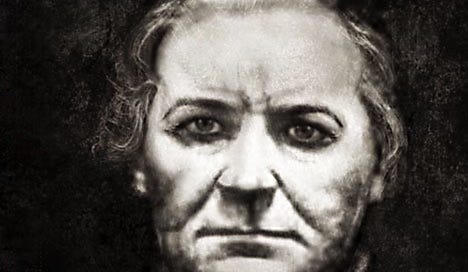(Trigger Warning: This blog post contains extremely disturbing and graphic descriptions of child death and abuse.)
The murky waters of the Thames, a silent observer of London's bustling life, yielded a horrifying secret on March 30th, 1896. Near Caversham Lock, a bargeman named Charles Humphreys, while hauling ballast, found himself entangled with a peculiar parcel. He pulled it aboard, his curiosity piqued. Inside, wrapped in layers of newspaper and linen, lay the tiny, lifeless body of a baby girl. A piece of tape, knotted tightly around her fragile neck, whispered a chilling tale of strangulation. This was no accidental drowning; this was cold-blooded murder. And it was just the first ripple in a tide of unimaginable horror.
The parcel, addressed to a Mrs. Thomas at 26 Piggott's Road, Caversham, was a cruel deception. Detective Constable Anderson, piecing together the fragments of this macabre puzzle, found a vital clue on the wrapping paper: a Midland Railway stamp dated October 24th, 1895, originating from Bristol Temple Meads. The false address was a desperate attempt at misdirection, but the stamp, a small detail overlooked by a killer's haste, led investigators to the true destination: 45 Kensington Road, Reading, the home of Amelia Dyer.
Dyer's residence wasn't a scene of squalor; it was a picture of deceptive domesticity. Seven individuals resided within: Dyer herself, a woman whose name would soon be etched in infamy; an elderly woman known only as Granny; three innocent children, Nellie Oliver, Willie Thornton, and a three-month-old infant; and a lodger, Mrs. Chandler, with her two daughters. But beneath this veneer of normalcy, a chilling industry of death thrived. Baby clothes, fifteen pawn tickets, children's vaccination certificates, receipts for newspaper advertisements, and tape identical to that found on the baby's neck – the evidence was damning.
But the most heartbreaking discoveries were the letters. Penned by desperate mothers, unwed, often destitute, and facing the harsh judgment of Victorian society, these letters were cries for help. They had turned to Dyer, believing she would care for their children, perhaps even find them loving homes. They paid her, trusting her with their most precious possessions. Instead, they were unknowingly consigning their infants to a cruel and premature death.
The stench of death clung to Dyer's bedroom, emanating from a large, locked tin box. Though empty when discovered, the box bore the grim evidence of its recent contents: a tiny corpse. This was no isolated incident; this was a business, a macabre enterprise built on the lives of innocent babies.
The social climate of Victorian England made such horrors possible. Unwed mothers were ostracized, left with few options. Workhouses were bleak, overcrowded institutions, and adoption was a complex and often unattainable process. Baby farming, though unregulated and rife with abuse, seemed like the only choice for some. Dyer, a master manipulator, exploited this desperation, becoming a trafficker of human lives.
The investigation expanded, ensnaring Arthur Palmer, Dyer's son-in-law. His home, too, yielded a trove of incriminating evidence. And then, the Thames, as if unable to contain its grim secrets any longer, began to relinquish more victims. One by one, the bodies of infants surfaced, each bearing the same chilling hallmarks: strangulation, careful wrapping, the telltale tape. Some were so decomposed that their heads separated from their bodies upon discovery.
The legal proceedings were a complex and frustrating dance of justice delayed. Dyer, feigning ignorance, was remanded time and again. The details are harrowing: the tearful testimonies of grieving mothers, the grim discoveries in the river, the ever-mounting evidence. Dyer's own mental state was called into question; her history of erratic behavior, suicide attempts, and claims of hearing voices painted a picture of a woman teetering on the brink of madness. But was it genuine, or a calculated performance to evade the hangman's noose?
The story doesn't end with Dyer's arrest. It continues with the discovery of more victims, each tiny life a poignant tragedy. Helena Fry, Doris Marion, Harry Simmons, Isaacs (whose real name was Francis Jessie Golding) – these are just a few of the names we know. Each child was entrusted to Dyer's care, only to be discarded like refuse. The coroner's inquests, though sometimes reaching questionable verdicts, added to the grim tapestry of evidence.
And then there was Arthur Palmer, initially arrested as an accessory, then released, only to be immediately re-arrested for the abandonment of another child, Queenie. He was eventually sentenced to hard labor, a chilling echo of Dyer's own crimes.
Finally, after a series of trials and delays, justice was served. Amelia Dyer was convicted of murder and sentenced to death. On June 10th, 1896, she was hanged at Newgate Prison. But the true death toll remains a chilling mystery. It's suspected that hundreds of babies met their end at her hands, their small lives extinguished for the paltry sum of ten or twelve pounds.
The case of Amelia Dyer is a dark stain on Victorian history, a horrifying testament to the vulnerability of the innocent and the depths of human depravity. It's a story that demands to be told, not for its sensationalism, but for the grim lessons it holds. It reminds us of the importance of social responsibility, the need for vigilance in protecting the most vulnerable, and the enduring power of even the smallest details to unmask the most monstrous of crimes.
For the full podcast episode check out episode 28 of Wyrd Wessex here



